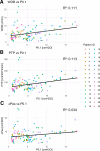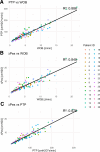P0.1 is an Unreliable Measure of Effort in Support Mechanical Ventilation in Comparison With Esophageal-Derived Measures of Effort: A Comparison Study
- PMID: 40638487
- PMCID: PMC12316126
- DOI: 10.1097/CCM.0000000000006745
P0.1 is an Unreliable Measure of Effort in Support Mechanical Ventilation in Comparison With Esophageal-Derived Measures of Effort: A Comparison Study
Abstract
Objective: Respiratory effort should be assessed in patients on mechanical ventilation in support mode. With the insertion of esophageal balloons, it is possible to measure different parameters of effort, such as change in esophageal pressure (ΔPes), work of breathing (WOB), and pressure-time product (PTP). Although some studies advocate for the use of P0.1 as a measure of effort, there is significant controversy as it is considered more a measure of respiratory drive. This study investigates the correlation between P0.1 and esophageal-derived parameters of effort.
Design: This was a retrospective observational comparison study.
Setting: This study is conducted in the mixed medical-surgical ICU at the Leiden University Medical Center (Leiden, The Netherlands).
Patients: Data were collected from 30 mechanically ventilated patients in spontaneous breathing mode.
Interventions: None.
Measurements and main results: From each patient, a minimum of three different time frames of 5 minutes were used to collect the average values of P0.1, WOB, PTP, and ΔPes over this time frame. Statistical models accounting for repeated measurements were applied to assess correlations among these parameters. In total, 117 timeframes were analyzed from 39 patient cases. The analysis revealed poor correlations between P0.1, as measured in this study, and WOB ( R2 = 0.111), PTP ( R2 = 0.113), and ΔPes ( R2 = 0.034), whereas the esophageal-derived parameters showed high correlations with each other (PTP vs. WOB, R2 = 0.886; ΔPes vs. WOB, R2 = 0.848; and ΔPes vs. PTP, R2 = 0.876).
Conclusions: The results demonstrated poor correlations between P0.1 and the other effort parameters, whereas strong correlations were observed among ΔPes, WOB, and PTP. These findings underscore the need for careful consideration of monitoring tools to ensure appropriate assessment and management, and the importance of using esophageal catheters for accurate monitoring of respiratory effort, particularly in spontaneously breathing patients.
Trial registration: ClinicalTrials.gov NCT06391424.
Keywords: P0.1; esophageal pressure swings; intensive care unit; mechanical ventilation; pressure-time product; work of breathing.
Copyright © 2025 The Author(s). Published by Wolters Kluwer Health, Inc. on behalf of the Society of Critical Care Medicine and Wolters Kluwer Health, Inc.
Conflict of interest statement
Outside of this work, Dr. Schoe has research collaborations (paid to the institution) with Hamilton Medical AG, Switzerland, Demcon-Macawi B.V., the Netherlands, MedLea Srl, Italy. He disclosed a research collaboration with Medlea Srl. Dr. Schoe, Ms. Smits, Ms. Rietveld, Mr. Snoep, and Ms. van der Velde-Quist also received speaker fees (paid to the institution) from Hamilton Medical AG, Switzerland. Prof. Dr. de Jonge has disclosed that he does not have any potential conflicts of interest.
Figures


Similar articles
-
Nasal pressure swings as the measure of inspiratory effort in spontaneously breathing patients with de novo acute respiratory failure.Crit Care. 2022 Mar 24;26(1):70. doi: 10.1186/s13054-022-03938-w. Crit Care. 2022. PMID: 35331323 Free PMC article.
-
Extracorporeal carbon dioxide removal for the treatment of acute hypoxaemic respiratory failure: the REST RCT.Health Technol Assess. 2025 Jul;29(33):1-16. doi: 10.3310/GJDM0320. Health Technol Assess. 2025 Jul;29(33):1-16. doi: 10.3310/GJDM0320. PMID: 40758387 Clinical Trial.
-
Home treatment for mental health problems: a systematic review.Health Technol Assess. 2001;5(15):1-139. doi: 10.3310/hta5150. Health Technol Assess. 2001. PMID: 11532236
-
[Volume and health outcomes: evidence from systematic reviews and from evaluation of Italian hospital data].Epidemiol Prev. 2013 Mar-Jun;37(2-3 Suppl 2):1-100. Epidemiol Prev. 2013. PMID: 23851286 Italian.
-
Melatonin for the promotion of sleep in adults in the intensive care unit.Cochrane Database Syst Rev. 2018 May 10;5(5):CD012455. doi: 10.1002/14651858.CD012455.pub2. Cochrane Database Syst Rev. 2018. PMID: 29746721 Free PMC article.
References
-
- Cornejo R, Telias I, Brochard L: Measuring patient’s effort on the ventilator. Intensive Care Med 2024; 50:573–576 - PubMed
-
- AK AK, Anjum F: Ventilator-induced lung injury (VILI). In: StatPearls [Internet]. Treasure Island, FL, StatPearls Publishing, 2025 - PubMed
-
- Yoshida T, Fujino Y, Amato MB, et al. : Fifty years of research in ARDS. Spontaneous breathing during mechanical ventilation. Risks, mechanisms, and management. Am J Respir Crit Care Med 2017; 195:985–992 - PubMed
Publication types
MeSH terms
Associated data
LinkOut - more resources
Full Text Sources
Medical

